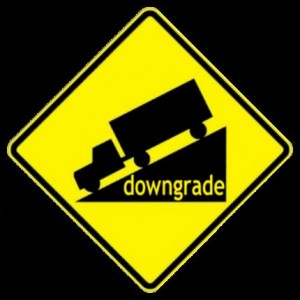
Fresh from Moody’s:
Moody’s changes Queensland’s rating outlook to nSydney, November 26, 2012 — Moody’s has changed the outlook on the State of Queensland’s Aa1 rating to negative from stable
RATINGS RATIONALE
The change in the outlook reflects the deterioration in the state’s financial performance which has persisted since fiscal 2007/08 and the resultant high levels of indebtedness. Scheduled improvements will only take hold in a few years, and progress could be slowed by the potential emergence of less supportive conditions.
At the same time, the Aa1 rating continues to reflect the state’s inherent credit strengths including its still strong budget flexibility, Commonwealth government support, ample levels of internal liquidity, and a diverse economic base with significant growth potential.
Queensland’s financial performance deteriorated over the past five years as the state faced mounting cost pressures related to the social service and infrastructure needs of a rapidly growing and urbanizing population in the south, as well as infrastructure demands in support of resource industries in the north. These pressures were exacerbated by a lack of expenditure discipline as spending continued to outpace revenues and by the impact of severe floods in 2011. From 2007/08 through 2011/12, general government sector deficits averaged annually a high 15% of revenues (net borrowing result).
Sizeable cash deficits — on a consolidated government basis — have led to a rapid rise in the state’s debt burden. Net direct and indirect debt increased from a moderate 58% of revenues, or 9% of GSP, in 2006/07, to 126% of revenues, or 21% of GSP, in 2011/12, and is projected to continue rising significantly before easing off over the medium term. On the positive side, Queensland is unique among Australian states in holding sufficient funds to fully fund its superannuation liabilities and its position remains strong when compared to its peers.
The state government has implemented a new fiscal redress plan that aims to restore budgetary balance by 2014/15, largely through constraining growth in expenditures to 2.5% on average over the next four years compared to the 8.7% registered over the past four years. This more prudent fiscal approach is a positive development, but actual improvements would take a few years and will be challenged by upward pressures on expenditures related to rapid population growth. The government’s ongoing resolve to carry out already identified expenditure restraints — as well as its ongoing efforts to seek additional savings — will be of key importance for Moody’s assessment of credit quality.
What Could Change the Rating — Up/Down
As noted, while the fiscal redress plan is a positive development, implementation will be challenging. A return to a stable outlook on the Aa1 rating would require the rapid achievement of a surplus position that is sustainable and leads to a decline in debt burden over the medium term. An inability to achieve this outcome, which would be beyond the stated targets of the plan, could result in a one notch downgrade of the rating.
Moody’s assigns long-term debt and issuer ratings of Aa1 to the Queensland Treasury Corporation (QTC), the entity that issues debt on behalf of the State of Queensland and state-owned corporations. QTC’s debt is guaranteed by the State of Queensland and the rating is based on the credit quality of the state. Moody’s also assigns a short term rating of Prime-1 to Queensland’s commercial paper program and Aaa ratings to QTC’s bond issuances guaranteed by the Commonwealth government.

